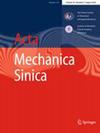Rubbing features of the bladed drum rotor under a novel coupled axial-radial thermal effect
Abstract
High temperatures in a gas turbine may lead to severe blade rubbing failure for the bladed thin drum rotor. It is essential to demonstrate such rubbing features. This paper established a bladed drum rotor model with blade rubbing induced by high temperatures. The analytical function of a coupled axial-radial temperature in the drum according to the actual thermal field analysis is obtained. The equations of motion for this rotor are derived. The dynamic model and its solution method are verified through the natural frequency comparison and the rub-impact response analysis. Thereafter numerical simulations are carried out. Results show that the heat at the turbine is transferred from its outer surface to its inner surface, then to the compressor’s inner surface along the axial direction, and finally from the compressor’s inner surface to its outer surface. This is a novel coupled axial-radial thermal effect for the gas turbine, which causes special axial and radial thermal gradients. The effect is induced by high temperatures in a gas turbine and intensifies a blade rubbing fault. Increasing the exhaust temperature aggravates the coupled axial-radial thermal effect, which causes more severe blade rubbing. Fortunately, introducing a lower temperature on the drum’s inner surface can prevent blade rubbing caused by this thermal effect.

 求助内容:
求助内容: 应助结果提醒方式:
应助结果提醒方式:


